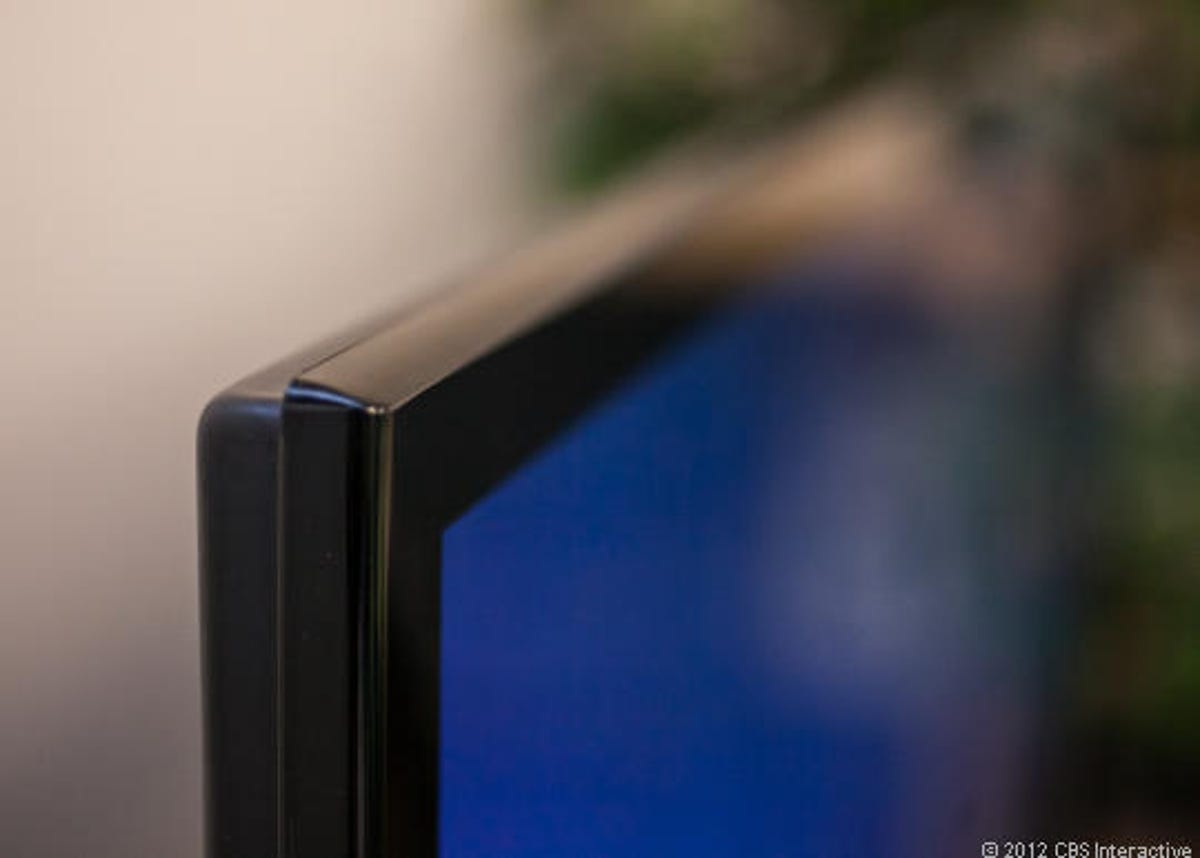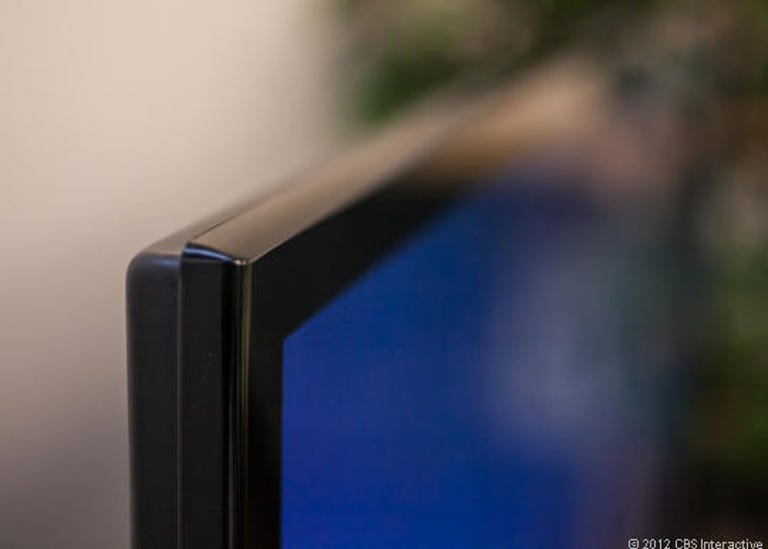 Why You Can Trust CNET
Why You Can Trust CNET LG LS4600 series review: LG LED TV fails to deliver
This LED TV looks nice itself, but its picture quality is another story.
When LED TVs arrived in a blitzkrieg of publicity several years ago, many consumers believed, mistakenly and with a lot of help from the advertisers, that this technology was automatically better than LCD. While LED lighting has some benefits, it's not necessarily going to give you better picture quality.
The Good
The Bad
The Bottom Line
The LG 47LS4600 LED is a case in point: when compared directly with the "LCD" Samsung E550, the LG suffers from much lighter blacks and desaturated colors.
While the LS4600 has some attractive design touches, like a slim bezel and rotating stand, the television's other problems, like a blotchy backlight and poor bright-room performance, mean it's not a great TV. When you consider that a TV like the TCL P60can outperform it in most picture tests at half the price, the LG LS4600 becomes a pretty poor deal.
| Models in series (details) | ||||
| LG 47LS4600 (reviewed) | 47 inches | |||
| LG 55LS4600 | 55 inches | |||
Design
Regardless of performance, let 2012 be remembered as the year LG found its design groove. TVs like the LM9600 are living room art, and while you can't expect this to flow all the way down the line, the LS4600 doesn't look like a budget TV.

This LG features a thin black bezel -- afforded by the edge-lit LED system -- and a fairly shallow profile. The television comes with a swivel stand as most TVs in LG's portfolio do, and this is a matter of differentiation between it and other brands. The stand is reminiscent of a PC monitor stand, which isn't such a bad thing.
The remote control is fully fledged with decent ergonomics and friendly buttons.
TV menus are usually one step removed from Excel spreadsheets in terms of excitement, but LG likes to make the experience a bit friendlier with its smartphone-like tiles. It's a shame the dedicated Network tile doesn't work, though.
| Key TV features | ||||
| Display technology | LCD | LED backlight | Edge-lit | |
| Screen finish | Glossy | Remote | Standard | |
| Smart TV | No | Internet connection | No | |
| 3D technology | No | 3D glasses included | No | |
| Refresh rate(s) | 120Hz | Dejudder (smooth) processing | Yes | |
| DLNA-compliant | Photo/Music/Video | USB | Photo/Music/Video | |
| Other:None | ||||
Features
When you start paying over $500 for a television, you can expect to start seeing some features. For example, the Philips PFL5907 has Smart TV and PC desktop streaming, while the Vizio M3D470KD adds the 3D alluded to in its name. The comparably priced LG lacks both big step-ups. It does offer 120Hz refresh rate, according to LG, but it behaves more like a 60Hz TV, with relatively poor motion resolution and no smoothing/dejudder option (not that I miss the latter).
While the television does have a LAN port and a dedicated Network section in the menu, this appears inactive (I connected it to our network but it only told me "Network failed"). LG couldn't provide additional information as to its function, and the manual and supporting materials make only passing reference to it.
Picture settings: Like many of the TVs in the LG range the LS4600 includes quite sophisticated controls to attempt tailoring the image to "reference" level. The amount of control is fairly impressive with both color management and grayscale control. As a result I could get a pretty looking graph out of this LG, but it's a pity the TV has problems that can't be corrected with these controls.
Connectivity: While many budget TVs include only two HDMI ports, the LG ups the complement to three. Additionally, you get two component inputs, a composite, a PC input, and a USB port for media playback.
Picture quality
The LS4600 was a relatively poor performer. The one-two punch of terrible black levels and intrusive backlight clouding means that for anything other than oversaturated computer animation, the TV just doesn't have the picture pep to justify the price. Color was a mixed bag, accurate yet undersaturated, and while video processing was a very good, it couldn't make up for this set's other issues.
Click the image at the right to see the picture settings used in the review and to read more about how this TV’s picture controls worked during calibration.
| Comparison models (details) | ||||
| Toshiba 40E220U | 40-inch LCD | |||
| LG 42CS560 | 42-inch LCD | |||
| TCL L40FHDP60 | 40-inch LCD | |||
| Samsung LN46D630 | 46-inch LCD | |||
| Samsung LN46E550F | 46-inch LCD | |||
| Panasonic TC-P65VT50 (reference) | 65-inch plasma | |||
Black level: If all you plan to watch are news broadcasts and sports, then the LG could be OK, but the demands of modern theatrical releases in a dark room might prove too much. You don't see too many nighttime scenes in sitcoms, but they are a mainstay of movies and even TV dramas, and that's where the LS4600 comes unstuck.
The LS4600 showed the lightest black levels of the seven TVs in my test. In a darkened room the blacks looked brown, and the rebel Romulan ship from "Star Trek" was indecipherable -- spoiled by big backlight clouds and light blacks.
Despite unconvincing black levels, shadow detail was very good. This may seem illogical given the reduced dynamic range of the set, but the LG had better shadow detail than both the Toshiba E220 and Samsung E550. That's small consolation though, since both TVs kicked its butt in terms of cinematic punch due to the deeper black levels.
Color accuracy: The LG LS4600 had very similar color reproduction to the Philips PFL5907, which meant that colors were relatively true to life. However, compared with vibrant performers like the Samsung E550 and Toshiba E220, the LG lacked saturation, and skin tone in particular appeared a little yellow. When this restrained color palette was combined with the low black levels of the TV, the effect was fairly underwhelming.
Video processing: While not enough to save the TV given its other faults, the LG at least has very good picture processing. It was able to relay Blu-ray movies at the correct cadence with no stuttering with 1080p/24 sources in our "I Am Legend" test. In addition the 1080i film test of a sports stand was again replayed without any judder and no moire between the tightly packed chairs.
On the other hand the TV delivered only 300 to 400 lines of motion resolution, which is uncharacteristic for a 120Hz television. I don't consider that a big deal, however, since I didn't notice any obvious blurring in program material.
Uniformity: LG's LS4600 and CS560 were the worst of the group, both exhibiting poor uniformity. The LS4600, despite being the more expensive of the two, was arguably worse, with visible backlight blotchiness across the whole screen, which could obscure details in a dark picture.
When you are standing off-axis, the TV's colors and already-poor black levels completely washed out leaving a very gray-looking image. At least the TV has a swivel stand so you can minimize these issues from some seating postions.
Bright lighting: The LG has quite a glossy screen, and under lights it proved to be very reflective. While in some cases this can mean that you get an illusion of higher contrast, the blacks were still blotchy and blue-looking in the case of this TV.
| GEEK BOX: Test | Result | Score |
|---|---|---|
| Black luminance (0%) | 0.0696 | Poor |
| Avg. gamma | 2.2188 | Good |
| Near-black x/y (5%) | 0.2798/0.2847 | Poor |
| Dark gray x/y (20%) | 0.3121/0.3294 | Good |
| Bright gray x/y (70%) | 0.3126/0.3291 | Good |
| Before avg. color temp. | 10348.0945 | Poor |
| After avg. color temp. | 6548.9993 | Good |
| Red lum. error (de94_L) | 2.479 | Average |
| Green lum. error (de94_L) | 2.5584 | Average |
| Blue lum. error (de94_L) | 1.2554 | Good |
| Cyan hue x/y | 0.2336/0.3215 | Average |
| Magenta hue x/y | 0.314/0.152 | Good |
| Yellow hue x/y | 0.4214/0.518 | Average |
| 1080p/24 Cadence (IAL) | Pass | Good |
| 1080i Deinterlacing (film) | Pass | Good |
| Motion resolution (max) | 350 | Poor |
| Motion resolution (dejudder off) | N/A | Poor |



